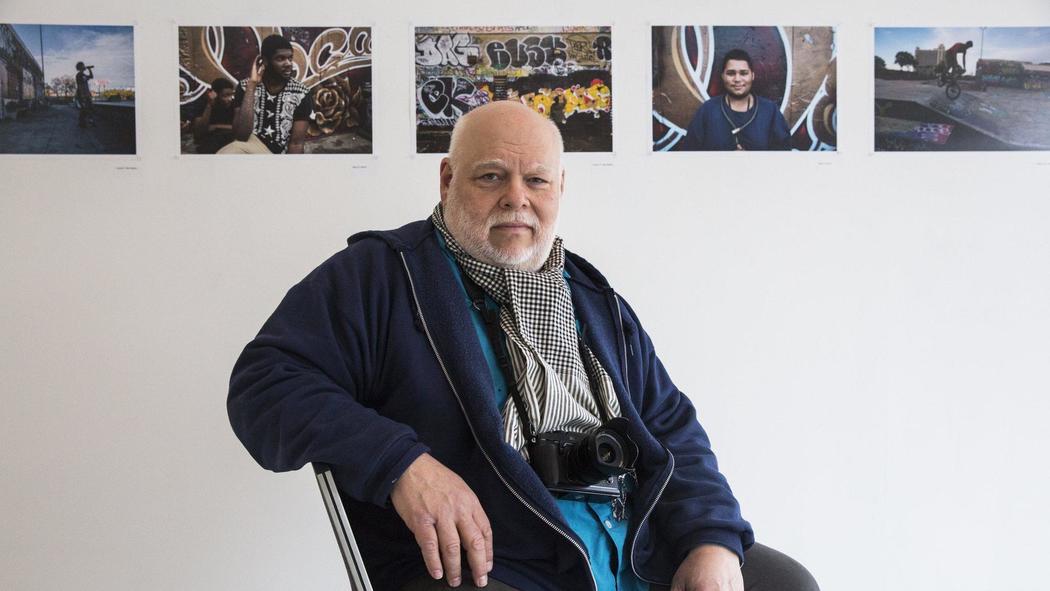Photographing Hartford

[Link to original story in Hartford Magazine and student photos]
Ostensibly, professor Pablo Delano teaches photography at Trinity College. But other subjects meander into the mix, like street smarts and community relations. On the second meeting of his introductory seminar for freshmen, he loaded all 12 shutterbugs into a van for a rollicking half-day tour of Hartford.
It was the gastronomical equivalent of a pub-crawl: they sampled falafel at Tangiers International Market; Salvadoran pupusas at Camilla's Latin Restaurant; and meat patties at Scott's Jamaican Bakery. They listened to restaurateurs talk about their neighborhoods and their lives. Delano and his charges also walked hither and yon.
Hartford, after all, would be the focus of their photographic odyssey for the next four months, and they needed to get familiar with their subject. Random "pointing and clicking" wasn't on the menu.
The first thing Delano impressed upon his class was that Hartford — the city he loves and has documented with his camera for 20 years — is worth knowing through personal experience, rather than by reputation only. "When students arrive there is a sense, which tends to dominate on campus, that Hartford is dangerous, that it is a bad place and that you shouldn't go beyond the college boundary," Delano said. "I think, of course, that that is wrong."
And before his students left the comforting confines of campus, their professor wanted them to have a plan, a focus if you will. They were required to select and research an aspect of the city to document.
This wasn't going to be a joy ride. Taking pictures, at least powerful and meaningful ones, is a serious undertaking: "One of the most difficult things I have to deal with is that everybody tends to think photography is fun," Delano said. "They don't realize how difficult, how much of a challenge it is. My idea of photography is something that goes deeper and has much more of a punch to it."
Another of Delano's challenges was confronting his students' manifest illiteracy — visual illiteracy, that is. He didn't want them coming back with "postcards" or pretty pictures that could accompany a travel article.
"I find that in terms of being able to decipher an image and get content out of it, they're very naïve," he said. "The most obvious kind of metaphor or symbolism that they might pick up easily in literature they can't understand in a picture. So one of the things I do is show them a lot of photographs. That's the most important thing for them to do, to look and look and look at pictures."
Among the images they examined were Delano's own photography, some of which will be displayed in an exhibit at the Hartford Public Library ArtWalk Gallery from May 19 to July 1. "Hartford Views" will include recent photos as well as some that were part of an earlier exhibit. Delano also has curated an installation of historic photos about Puerto Rico, where he was born; it is on display through March 16 at the King Juan Carlos I of Spain Center at New York University.
Having mastered the basics of their DLSR cameras, Delano's dozen dispersed. They took the bus, biked, walked, drove, and Uber-ed all over town. Adam Anderson, a suburbanite from Minnesota, studied a map of the city and was struck by the number and size of Hartford's parks; he photographed six of them — from the inside out, with the urban setting as the backdrop.
Kate Lucas concentrated on the recent and controversial moving of Gold Street. Katrina Rodriguez took portraits of housing stock, from mansions to colorful, visually compelling tenements. Cole Wright illustrated the two faces of Hartford: the city by day and after 5 p.m. His photograph of people waiting for a city bus to take them home on a dreary, rainy late afternoon evokes the grind of the daily commute.
Katherine Goguen and Mary Handy teamed up to chronicle the Heaven Skate Park, a popular neighborhood hangout resplendent with graffiti. Lauren Mac Master also plied the park, capturing a wonderfully framed shot of a skateboarder at rest with the glowing signage of the troubled Dunkin' Donuts Park in the background. This thought-provoking image could be titled "A Tale of Two City Spaces."
Goguen and Handy wanted a challenge — to interact with people as well as spaces — and the skate park fit the bill. "The first time I went I was intimidated, just by the unknown and how people would react to us," Goguen said. "At first, there were definitely some odd glances at us, but honestly, after 20 minutes, we were all talking and sitting around a picnic table getting to know each other. Everyone was so open to us taking photos. We wound up exchanging emails, and I'd send them photos of what I'd taken, and some of them followed us on Instagram."
Among the students' photos exhibited in January at the Broad Street Gallery, just outside Trinity's campus, was Mary Handy's portrait of a young man wearing his bicycle lock like a necklace. He has a welcoming face and a wry smile.
Delano's dozen were diverse in their background as well as visual acumen, but all seem to get his message that worthwhile photography requires hard work. "Some of them had the knack for it, but talent is overrated," he said. "Even when kids don't have natural talent, if they fall in love with it, they can be fantastic."
The students report that the experience has given them a new and improved impression of Hartford, that friends now ask them for advise on where to go and dine in the city. Goguen and Handy became virtual regulars after 20 visits to the Heaven Skate Park. They even acquired nicknames. Goguen wore flannel on one visit and thereafter she was known as "Plaid."